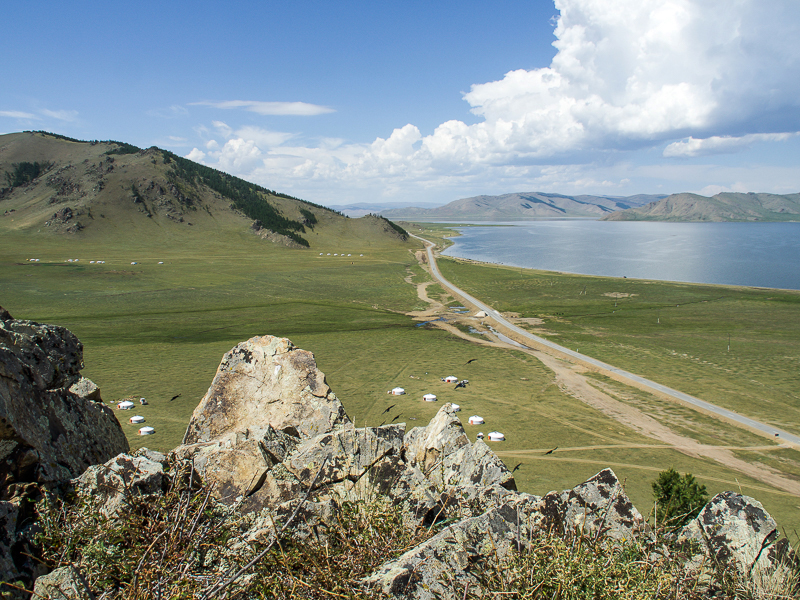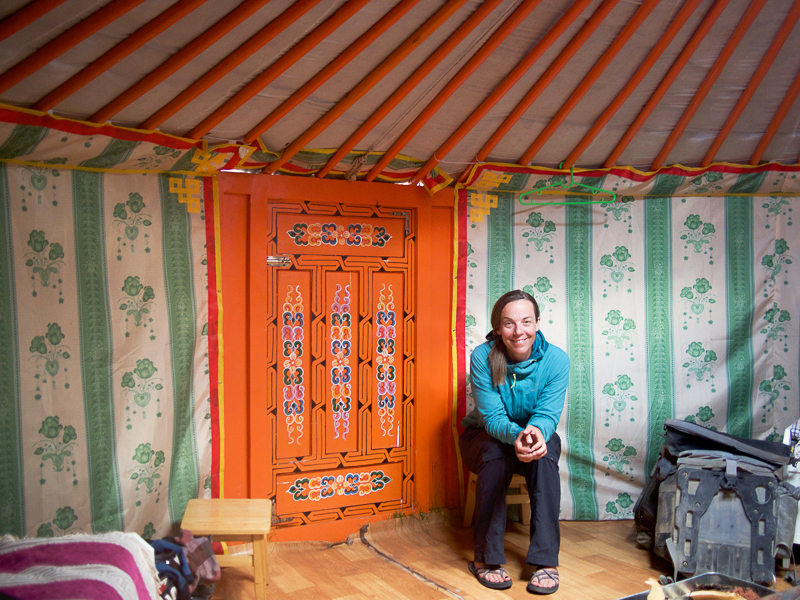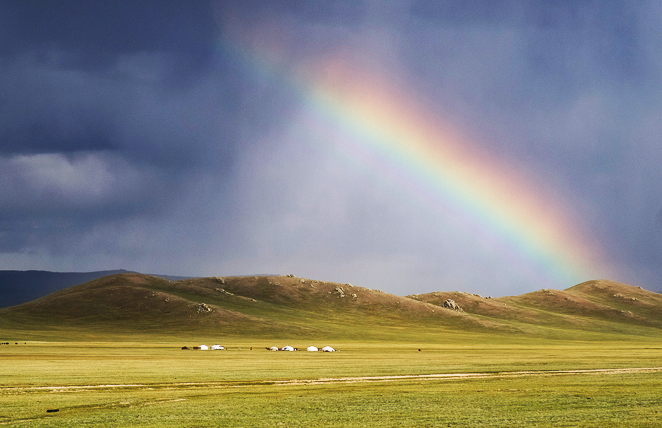WHITE LAKE, Mongolia — My first-ever experience staying in a yurt was in this far-flung Mongolian outpost. I was on a cross-country motorcycle tour with my boyfriend Dave, and while en route to the country’s capital, Ulaanbaatar, we stopped in this remote area where residents still embrace the nomadic lifestyle.
The Mongolians we met had set up their homesteads in the beautifully barren steppes and stay here for months before moving on with their herds.
Because of this age-old tradition, yurts are still the most common type of home in Mongolia, and even in Ulaanbaatar, almost half the population of 1.31 million still live in these traditional abodes.
Yurts, or gers, as they are called locally, have been used as portable dwellings for over 3,000 years by nomadic travellers in Central Asia.

Above: A community of yurts dots a Mongolian valley. The nomad lifestyle is treasured here.
They take, an average, two hours to set up and seem rather immobile in comparison to nylon tents used by modern travellers. Yurts were originally designed to be easily broken down and carried by camels or yaks when it was time to move on.
The large, but short round tents, usually covered in what looked like white canvas, stood out on the treeless, windswept steppes as we rode past.
Inhabitants are forced to stoop while exiting and entering through the squat doorways — I imagined they were designed to keep heat in or out, depending on the time of year. They reminded me of the teepees the Great Plains tribes of North American used for centuries.
The conventional yurt’s roof consists of a sequence of latticework made from pieces of wood or bamboo, usually traded in river valleys or along the Silk Road.
Once in place, the latticework is covered in skins or felt, acquired from herd animals, like sheep and yaks, that travel with the nomads.
A compression ring at the crown keeps everything in place, aided by the weight of the yurt’s covers and sometimes supplemented with a heavy weight hung from the centre.


Left: Writer needs to bend over to get inside the yurt. Right: A rainbow canopies the yurts in a valley.
Once established, the yurt offers a surprising amount of insulation and protection from the elements. Their round shape makes them virtually indestructible during gusting winds from any direction, which the Siberian steppes can experience often. Temperatures here can reach as high as 25C and all the way down to -30C, but inside the yurt stays temperate.
We were able to find out all about the gers after riding through the remote region near White Lake and stopping after a particularly exhausting day at a yurt camp we found along the road.
White Lake was shimmering in the late afternoon sun, with a series of about 20 white yurts set back from the shoreline. Dave and I immediately booked two nights, not even looking inside, just sure we’d welcome the relaxed lakeside setting and the modest staff providing yak stew and warm beer.
After filling our stomachs, Dave and I went inside our yurt to explore. The door was less than five feet high and the interior about six feet, with the centre rising to just over seven feet at the crown.
The wooden poles that had been put in place for the ceiling were beautifully and painstakingly hand-painted, as was the door. Half a dozen single beds ringed the gers canvas walls and an iron wood stove with a chimney extended up through the crown, which is left open to allow air to circulate.
Although it was hot enough during the day to swim in White Lake, the evenings would cool off considerably and we appreciated the fire that warmed our living space.

Above: Camels are still the favoured means of transportation by the nomadic people of Mongolia.
Yurt camping today has seen a trendy increase as a rustic option for charming tourist accommodation. They are usually built now as permanent structures on wooden platforms and the steam-bent wood framing is covered in canvass or tarpaulin. Beautifully hand-painted doorways remain a colourful addition, nicely offset with the white canvass siding, and the interior can be anything from basic to luxury, depending on your budget and comfort requirements.
Our ger at White Lake was not luxurious, but there are yurt camps in the area that are much better serviced.
An overland expedition to White Lake is a fantastic way to see the country and talk with locals, although be sure you and your travel partner are hardy enough to withstand hours of bumpy off-roading leading to your yurt camp, complete with primitive pit toilets, outdoor, cold-water hand washing stations and locally-sourced food, which is often sinewy yak meat served on plates washed in lake water.
So, can you think of a reason not to go?
About the Author
Heather Lea has had over two decades of freelance writing experience with over 60 published articles and stories in various travel and outdoor publications. From 2005 to 2015, she founded and operated an arts and culture magazine in Revelstoke, B.C. before selling her business to help fund her trip around the world. More stories of Heather's adventures can be found at http://www.ridingfullcircle.com